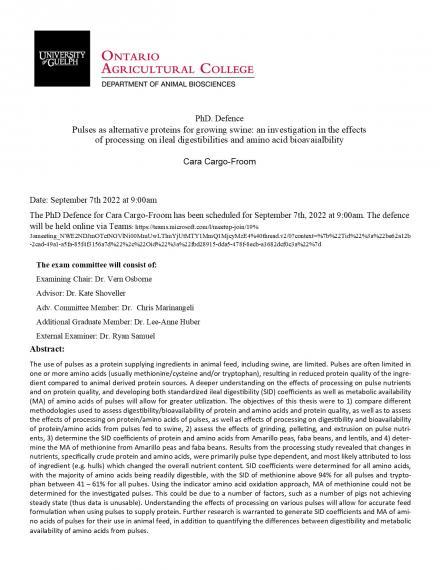Cara Cargo-Froom
Date and Time
Location
Teams: https://teams.microsoft.com/l/meetup-join/19%3ameeting_NWE2NDJmOTctNGVlNi00MmUwLTlmYjUtMTY1MmQ1MjcyMzE4%40thread.v2/0?context=%7b%22Tid%22%3a%22be62a12b-2cad-49a1-a5fa-85f4f3156a7d%22%2c%22Oid%22%3a%22fbd28915-dda5-478f-8ecb-a3682dcf0c3a%22%7d

Details
The use of pulses as a protein supplying ingredients in animal feed, including swine, are limited. Pulses are often limited in one or more amino acids (usually methionine/cysteine and/or tryptophan), resulting in reduced protein quality of the ingredient compared to animal derived protein sources. A deeper understanding on the effects of processing on pulse nutrients and on protein quality, and developing both standardized ileal digestibility (SID) coefficients as well as metabolic availability (MA) of amino acids of pulses will allow for greater utilization. The objectives of this thesis were to 1) compare different methodologies used to assess digestibility/bioavailability of protein and amino acids and protein quality, as well as to assess the effects of processing on protein/amino acids of pulses, as well as effects of processing on digestibility and bioavailability of protein/amino acids from pulses fed to swine, 2) assess the effects of grinding, pelleting, and extrusion on pulse nutrients, 3) determine the SID coefficients of protein and amino acids from Amarillo peas, faba beans, and lentils, and 4) determine the MA of methionine from Amarillo peas and faba beans. Results from the processing study revealed that changes in nutrients, specifically crude protein and amino acids, were primarily pulse type dependent, and most likely attributed to loss of ingredient (e.g. hulls) which changed the overall nutrient content. SID coefficients were determined for all amino acids, with the majority of amino acids being readily digestible, with the SID of methionine above 94% for all pulses and tryptophan between 41 – 61% for all pulses. Using the indicator amino acid oxidation approach, MA of methionine could not be determined for the investigated pulses. This could be due to a number of factors, such as a number of pigs not achieving steady state (thus data is unusable). Understanding the effects of processing on various pulses will allow for accurate feed formulation when using pulses to supply protein. Further research is warranted to generate SID coefficients and MA of amino acids of pulses for their use in animal feed, in addition to quantifying the differences between digestibility and metabolic availability of amino acids from pulses.